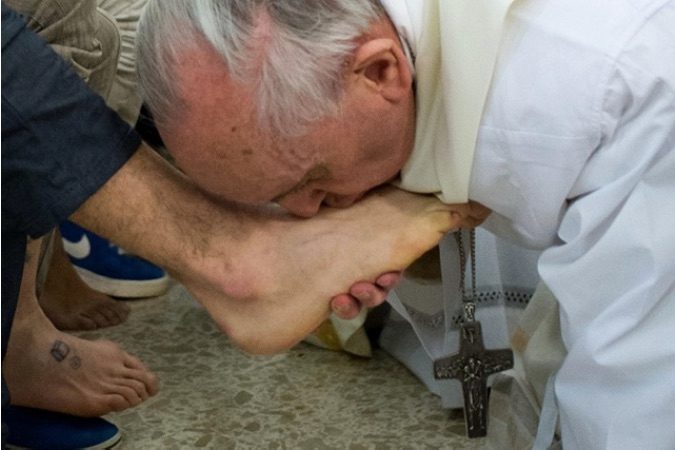SUMMARY
This is AI generated summarization, which may have errors. For context, always refer to the full article.

MANILA, Philippines (UPDATED) – Shortly before the Holy Communion during Maundy Thursday, churchgoers will witness priests washing the feet of 12 persons, dressed like the apostles of Christ in the Bible. The ceremony is observed not only by Catholics but also in the respective religious services of eastern Orthodox churches, Anglican churches, and some Protestant denominations.
The religious ritual was inspired by a biblical account of that fateful night before Jesus Christ’s passion, crucifixion, and death.
John, one of the apostles, described in the 13th chapter (verses 1-17 of his gospel), Jesus Christ’s rare act of washing the feet of his disciples during dinner, now known as the Last Supper.
“The evening meal was in progress, and the devil had already prompted Judas, the son of Simon Iscariot, to betray Jesus. Jesus knew that the Father had put all things under his power, and that he had come from God and was returning to God; so he got up from the meal, took off his outer clothing, and wrapped a towel around his waist. After that, he poured water into a basin and began to wash his disciples’ feet, drying them with the towel that was wrapped around him,” a passage from the chapter goes.
A slave’s duty
Historically, the feet-washing was a common practice in Eastern countries because people wore sandals and walked on dusty roads.
There are biblical allusions to the practice of feet-washing. In the Old Testament, the act was described as a lowly service as it was performed by slaves on guests especially in well-off households.

That is why the disciples were surprised by the humble gesture of their preacher, prompting apostle Peter to protest, “Lord, are you going to wash my feet?” Peter asked, to which Jesus Christ replied, “You do not realize now what I am doing, but later you will understand.”
“No, you shall never wash my feet,” Peter protested.
Jesus Christ answered, “Unless I wash you, you have no part with me.”
Service and humility
The biblical story of the feet-washing ceremony is mainly interpreted as an act of humility and service, a recurring message in the observance of the Holy Week.
Explaining the significance of the washing of the feet and the Mass on Holy Thursday, Pope Francis said at his weekly audience in St Peter’s Square on March 23 that the “Eucharist is love that is done through service” to others.
“In giving himself to us as food, Jesus attests that we must learn to break this nourishment with others so that it may become a true communion of life with those who are in need. He gives himself to us and asks us to remain in him in order to do the same,” he said.
Shortly after his election in 2013, Pope Francis visited a youth detention center where he performed the washing of feet ritual on a group of young inmates – including two Muslims, the first Catholic leader ever to do so. (READ: Pope to prisoners: I’m at your service)
It was during the Last Supper when Jesus Christ gave a new “commandment” to his disciples: “A new commandment give I unto you, that you love one another, as I have loved you,” John wrote towards the latter part of chapter 13 of his gospel.
Maundy Thursday is particularly inspired by the verse. The word “maundy” is derived from the Latin word “mandatum” which literally means “command.”
The Christian world, including the Philippines, a Catholic-dominated country, is observing the Lenten season. – Rappler.com
Editor’s note: An earlier version of this article was published here on Rappler in 2012.
Add a comment
How does this make you feel?
There are no comments yet. Add your comment to start the conversation.